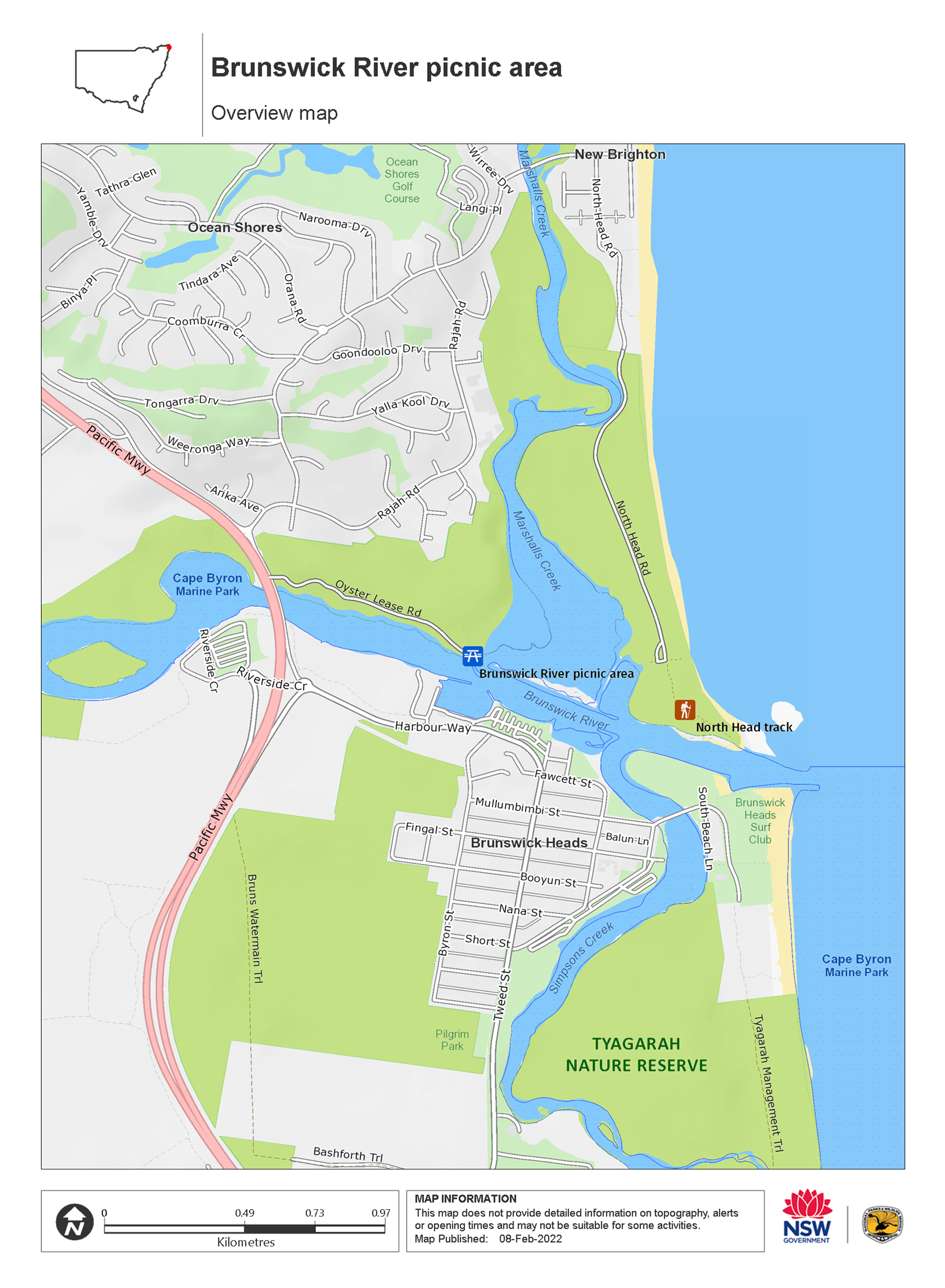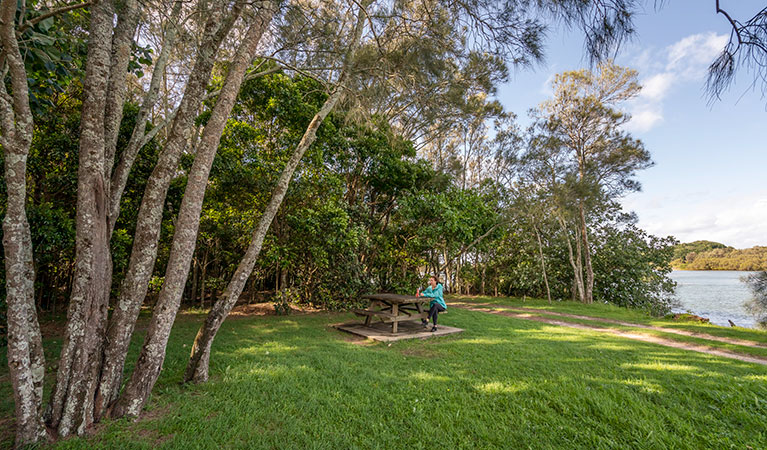Overview
Brunswick River picnic area is a great place to enjoy this peaceful reserve, with scenic views, easy access to fishing and plenty of birdwatching opportunities.
- Type
- Picnic areas
- Accessibility
- Medium
- What to
bring - Drinking water
- Please note
- This area is within Cape Byron Marine Park. Next to the fishing area is a sanctuary zone, where fishing is not permitted. Check out the Marine Parks Authority website for more information or call on 6620 9300.
- Remember to take your binoculars if you want to bird watch
Brunswick River picnic area is a great place to enjoy this peaceful coastal reserve, with views of the river and easy-to-access fishing spots. Enjoy lunch with friends and family in the shade of cottonwood hibiscus, which shows its large yellow flowers in the warm weather, and listen to the wind gently whoosh through the swamp oaks. Then cast a line and relax.
The access road to this picnic area is lined with many threatened rainforest trees, such as marblewood and stinking laurel (which doesn’t actually stink). In spring, the brilliant purple flowers of the hovea bush decorate the way as well.
This quiet spot is ideal for birdwatching. Pied oystercatchers feed on the rocks, while birds of prey - brahminy kites and white-bellied sea eagles – soar overhead. If you’re really lucky, you’ll see an osprey stealthily snatch a fish from the water.
Map

Map legend

Local alerts
For the latest updates on fires, closures and other alerts in this area, see https://www.nationalparks.nsw.gov.au/things-to-do/picnic-areas/brunswick-river-picnic-area/local-alerts
General enquiries
- National Parks Contact Centre
- 7am to 7pm daily
- 1300 072 757 (13000 PARKS) for the cost of a local call within Australia excluding mobiles
- parks.info@environment.nsw.gov.au
Park info
- in Brunswick Heads Nature Reserve in the North Coast region
Brunswick Heads Nature Reserve is always open but may have to close at times due to poor weather or fire danger.
Visitor info
All the practical information you need to know about the Brunswick River picnic area.
Getting there and parking
Brunswick River picnic area is in the Oyster Lease precinct of Brunswick Heads Nature Reserve. To get there:
- Drive north from Brunswick Heads along Brunswick Valley Way and cross Brunswick River on Durrungbil Bridge
- When on the northern side, do a U-turn at the first roundabout (Rajah Road) to head south along Brunswick Valley Way.
- Take the first left into Oyster Lease Road
- Follow to the carpark at the end
Road quality
- Unsealed roads
Vehicle access
- 2WD vehicles
Weather restrictions
- All weather
Parking
There's parking in a gravel carpark at Brunswick River picnic area.
Best times to visit
There are lots of great things waiting for you in Brunswick Heads Nature Reserve. Here are some of the highlights.
Spring
During this season humpback whales accompanied by new calves and migratory shorebirds can be seen. Look out for bar-tailed godwits, which undertake the longest non-stop migratory flight of any bird in the world.
Winter
Late June and early July is the peak time to see humpback whales migrating north to mate and calve in tropical waters. New Brighton Beach and the north wall of Brunswick River are the best viewing spots.
Weather, temperature and rainfall
Summer temperature
Average
20°C and 27°C
Highest recorded
35.1°C
Winter temperature
Average
12°C and 19.5°C
Lowest recorded
3.3°C
Rainfall
Wettest month
March
Driest month
September
The area’s highest recorded rainfall in one day
350.4mm
Facilities
Drinking water is not available in this area.
Picnic tables
Step-free access
The picnic area is mostly flat and step-free. There are a range of surfaces including flat grass, hard-packed ground and soft sand.
Maps and downloads
Accessibility
Disability access level - medium
The picnic area is mostly flat and step-free with a mixture of surfaces including flat grass, soft sand, gravel and hard-packed ground. People with reduced mobility may need assistance on some of these surfaces.
Permitted
Fishing
A current NSW recreational fishing licence is required when fishing in all waters.
Prohibited
Fishing
- This area is within Cape Byron Marine Park. Next to the fishing area is a sanctuary zone, where fishing is not permitted. Check out the Marine Parks Authority website for more information or call on 02 6620 9300.
- Spear fishing is prohibited here and in all of the Brunswick estuary
Pets
Pets and domestic animals (other than certified assistance animals) are not permitted. Find out which regional parks allow dog walking and see the pets in parks policy for more information.
Smoking
NSW national parks are no smoking areas.
Learn more
Brunswick River picnic area is in Brunswick Heads Nature Reserve. Here are just some of the reasons why this park is special:
A home by the beach

Forty-three threatened animal species have been recorded in and around the reserve. Humpback whales can be seen off the coast during the migration period, and the world's smallest fruit bat called common blossom, which is just 6cm long, can also be seen. Other animals include the grey-headed flying fox, wallum froglet, long-nosed potoroo and koala. Critically endangered loggerhead turtles and vulnerable green turtles sometimes nest on New Brighton Beach. Brunswick Heads Nature Reserve is also home to threatened pied oystercatchers, sooty oystercatchers and beach stone-curlews.
- Brunswick Heads guided beach fishing adventures Visit beautiful Brunswick Heads Nature Reserve for a guided fishing excursion with Wilderness Adventures. Whether you’re a seasoned angler honing your technique or just want a relaxing day on the beach, their experts have an experience custom-made for you.
- Brunswick River picnic area Brunswick River picnic area is a great place to enjoy this peaceful reserve, with scenic views, easy access to fishing and plenty of birdwatching opportunities.
- North Head walking track A short easy walking route on North Head walking track through coastal rainforest to Brunswick River with scenic views and chances for picnicking, whale watching and birdwatching.
Land of plenty

Brunswick Heads Nature Reserve lies within the traditional land of the Bundjalung people. The area, once a campground, continues to provide a ready source of food such as dugum (pipis) and julum (fish). Harrys Hill is known as "Durrungbil', which means "water rat". When viewed from the south side of Brunswick River at the right angle, the profile of that water rat can clearly be seen.
Safe haven

Thirty-six threatened plant species have been recorded in the reserve. Brunswick Heads is a stronghold for many endangered rainforest plants that are either at the southern limit of their distribution or not found in many other places in New South Wales. These include Queensland xylosma, scented acronychia, durobby and white lace flower. The reserve also supports six endangered ecological communities (EEC), including littoral rainforest, swamp sclerophyll forest and coastal saltmarsh.
- Brunswick River picnic area Brunswick River picnic area is a great place to enjoy this peaceful reserve, with scenic views, easy access to fishing and plenty of birdwatching opportunities.
- North Head walking track A short easy walking route on North Head walking track through coastal rainforest to Brunswick River with scenic views and chances for picnicking, whale watching and birdwatching.
Plants and animals protected in this park
Animals
-

Humpback whale (Megaptera novaeangliae)
The humpback whale has the longest migratory path of any mammal, travelling over 5000km from its summer feeding grounds in Antarctica to its breeding grounds in the subtropics. Its playful antics, such as body-rolling, breaching and pectoral slapping, are a spectacular sight for whale watchers in NSW national parks.
-

White-bellied sea eagle (Haliaeetus leucogaster)
White-bellied sea eagles can be easily identified by their white tail and dark grey wings. These raptors are often spotted cruising the coastal breezes throughout Australia, and make for some scenic bird watching. Powerful Australian birds of prey, they are known to mate for life, and return each year to the same nest to breed.
-

Grey-headed flying-fox (Pteropus poliocephalus)
The grey-headed flying fox is Australia's largest native bat, with a wingspan up to 1m. This threatened species travels up and down south-eastern Australia and plays a vital role in pollinating plants and spreading seeds in our native forests.

